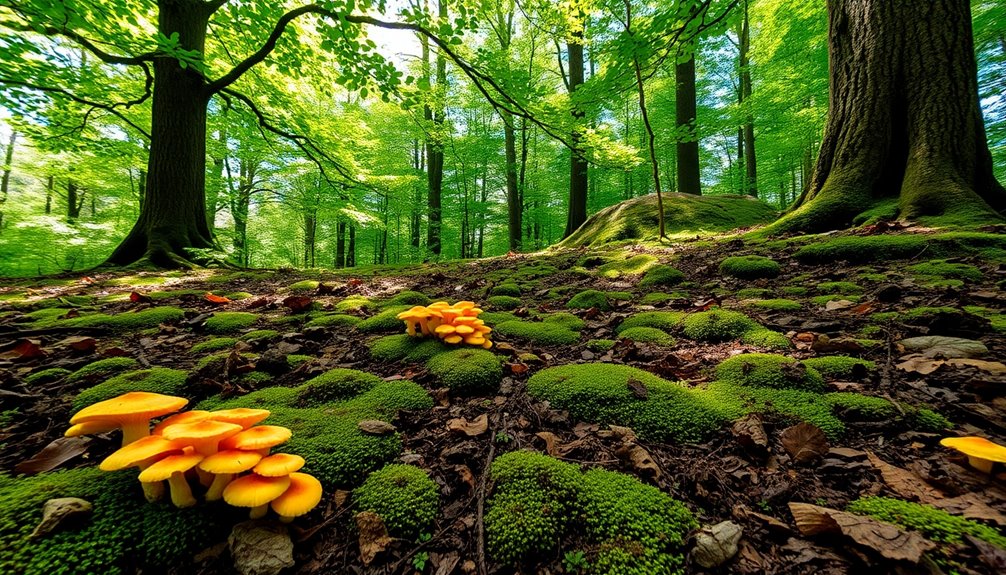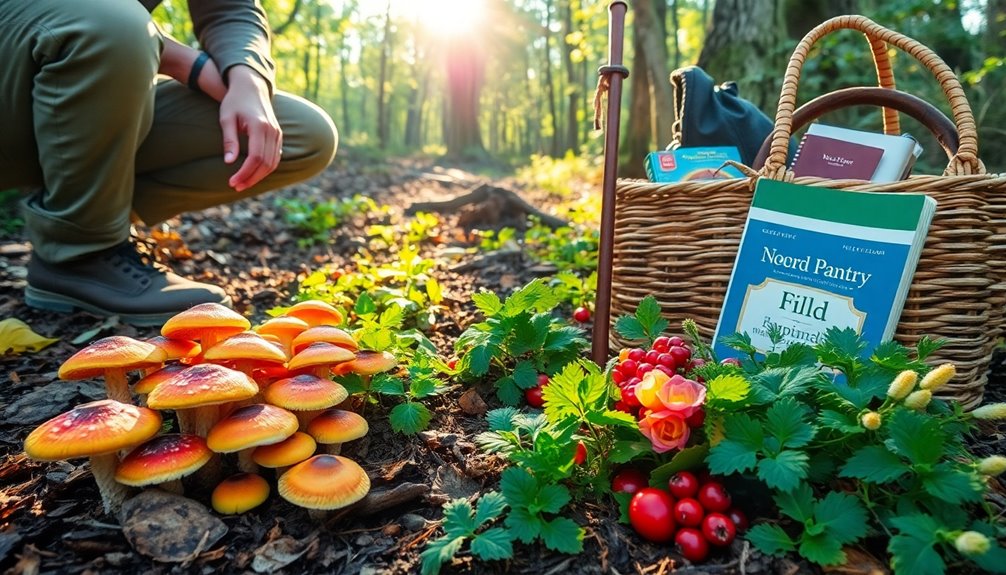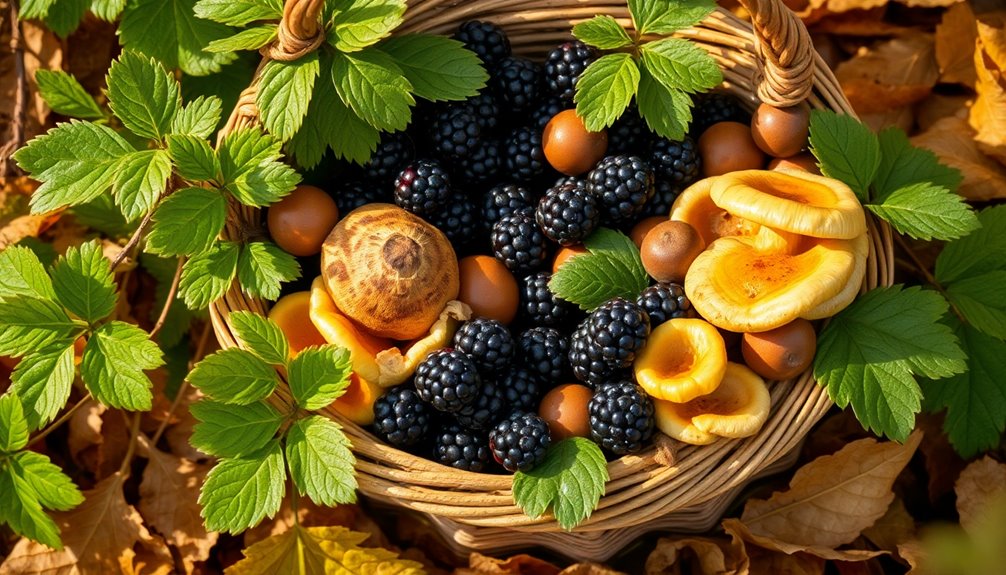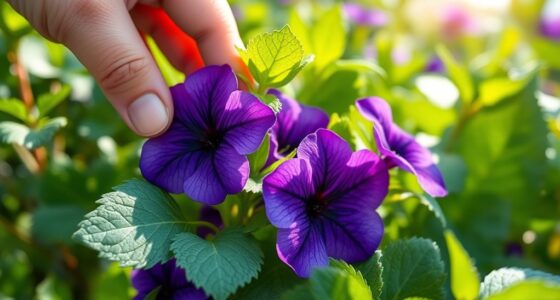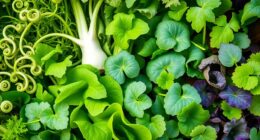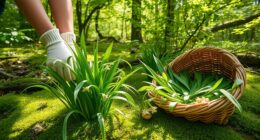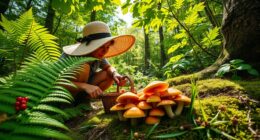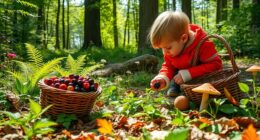Mushroom foraging happens in rich, wooded areas where diverse flora thrives. Look for forest floors around ash, elm, poplar, and oak trees. Locations like Lake James, NC, and Redwood Highway in CA are known havens for culinary delights such as morels and chanterelles. These tasty mushrooms often hide beneath leaf litter, waiting for you to discover them. Always guarantee you've got the right tools and knowledge to safely identify edible varieties, and practice ethical foraging. There's so much more to uncover about this rewarding hobby—let's explore the culinary and environmental benefits together!
Key Takeaways
- Foraging often occurs near specific trees like ash, elm, poplar, and oak, particularly for morels.
- Lake James, NC boasts mixed hardwood forests and floodplains, ideal for finding morels.
- South Mountains State Park offers diverse habitats with rich, loamy soil for various edible mushrooms.
- Redwood Highway, CA is renowned for chanterelles and porcini mushrooms during autumn months.
- Jackson State Forest provides access to a variety of wild mushrooms thriving beneath specific trees.
Foraging Basics and Techniques

When you're heading out to forage for edible mushrooms, what do you need to secure a successful outing? First, gather your essential tools: a hand lens for close inspection, a sharp knife for careful cutting, and a flat-bottomed basket for proper collection. These tools will help you identify and collect mushrooms effectively.
Protective clothing is also vital. Wear long pants and long-sleeved shirts to shield yourself from poison ivy and insect bites while you navigate the woods.
Knowledge is your best ally; familiarize yourself with over 1,200 mushroom types in the Chicago area. Misidentifying a toxic species can lead to serious health risks, so take the time to learn what to pick.
When you find those edible mushrooms, wrap them in wax paper or use wax paper bags to keep them fresh and prevent drying out. This maintains their quality for culinary use.
Remember, ethical foraging practices are important—respect the natural habitat and only take what you need. This way, you'll sustain mushroom populations for future harvesting while enjoying the thrill of mushroom picking.
Happy foraging!
Prime Locations for Mushroom Hunting
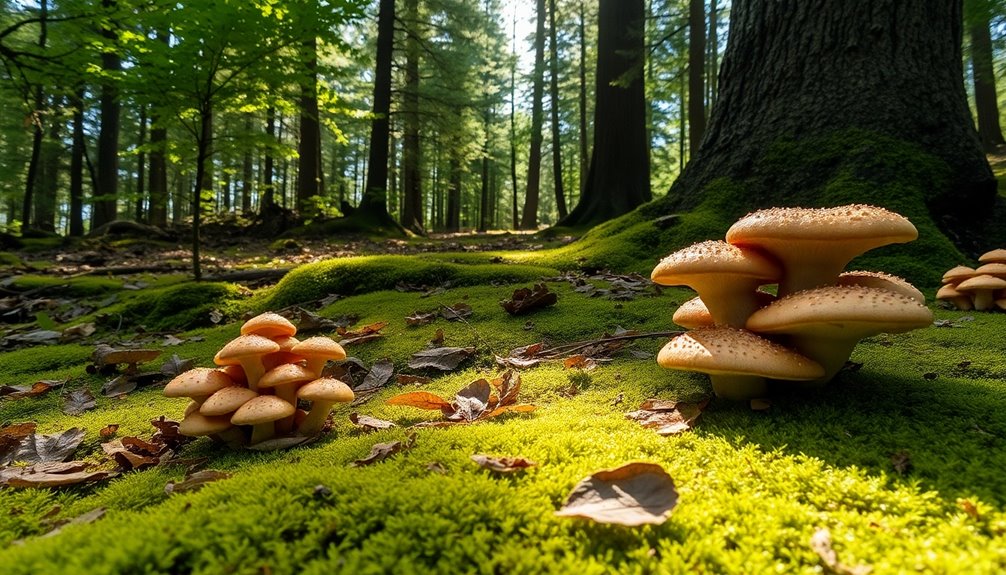
Finding prime locations for mushroom hunting requires a keen eye for specific environments that support mushroom growth. When you're out mushroom foraging, look for areas with tree associations like ash, elm, poplar, and oak, as these trees tend to foster morel growth.
For instance, Lake James in North Carolina boasts mixed hardwood forests and floodplains, providing the moist, rich soil that's perfect for finding morels during peak season.
South Mountains State Park is another excellent spot, featuring diverse habitats and rich, loamy soil, making it a favorite for foragers.
If you're in Northern California, don't miss the Redwood Highway, known for its chanterelles and porcini mushrooms that attract many pickers in the autumn.
Finally, consider the Jackson State Forest, where you can access a wide range of wild mushrooms. This area supports mycorrhizal species that thrive under specific trees and conditions.
Key Edible Mushroom Species

When you're out foraging, knowing key edible mushroom species can make all the difference.
Chanterelles, with their golden hue, offer a fruity aroma, while black trumpets bring a rich flavor to your dishes.
Don't overlook red pine mushrooms, as their bright orange ribs make them family favorites in the kitchen.
Chanterelles: Golden Treasures
Chanterelles, often dubbed golden treasures, are among the most sought-after edible mushrooms for their stunning yellow-gold hue and delightful apricot aroma. If you're looking to forage for wild mushrooms, these beauties are a must. Typically found in moist, wooded areas from late summer to early autumn, chanterelles thrive in symbiotic relationships with oak trees, exchanging nutrients and enriching the forest ecosystem.
When identifying chanterelles, look for their smooth to ridged undersides, which help distinguish them from the toxic jack-o-lantern mushroom, known for its well-developed gills. The vibrant color and unique scent make chanterelles a favorite among culinary enthusiasts, enhancing any dish they grace.
Recent DNA analysis has uncovered multiple distinct species within the chanterelle genus, emphasizing the importance of conservation efforts for these unique fungi.
As you venture out, remember to respect nature and forage sustainably, ensuring that future generations can also enjoy the culinary gold these mushrooms provide.
With a little patience and practice, you'll soon be reaping the rewards of your foraging adventures, savoring the rich flavors and aromas of freshly harvested chanterelles in your kitchen.
Black Trumpets: Culinary Delights
Black trumpets, known for their distinctive funnel-shaped caps and rich, smoky flavor, are a true gem in the world of foraged mushrooms. These culinary delights are highly sought after for their unique taste, often enhancing gourmet dishes. You'll typically find black trumpets growing in clusters on forest floors, especially under oak and other hardwood trees in deciduous or mixed woodlands.
Their dark caps and lack of true gills make them easy to identify. As you venture out during the harvesting season from late summer to early autumn, keep an eye out for these treasures, particularly after rainfall when moisture levels are ideal.
To give you a better idea of their culinary significance, here's a quick comparison:
| Feature | Black Trumpets |
|---|---|
| Flavor | Smoky and earthy |
| Typical Habitat | Deciduous and mixed woodlands |
| Harvest Season | Late summer to early autumn |
| Price Range | $20 to $50 per pound |
| Identification | Dark, funnel-shaped caps without gills |
With their unique flavor and market value, black trumpets are indeed a must-try for any mushroom enthusiast.
Red Pine: Family Favorites
Red pine mushrooms, often referred to as saffron milkcaps, are a delightful find for any forager. Identifiable by their dull orange/brown caps and bright orange ribs underneath, they stand out in the forest near red pines.
You'll typically find these mushrooms thriving from late summer to early autumn, especially after rain, nestled beneath the protective blanket of pine needles.
When foraging, keep an eye out for these mushrooms in mixed coniferous forests, as they prefer specific tree associations. Red pine mushrooms can grow up to 15 cm in diameter, making them a substantial addition to your culinary repertoire.
Once you've gathered your bounty, preparation is simple: scrub, slice thickly, and fry them in good-quality butter for 5-7 minutes. This will enhance their rich flavor, perfect for various dishes.
Beyond their culinary appeal, red pine mushrooms offer nutritional benefits, packed with minerals and trace elements that surpass those found in grains and plants.
Identifying Edible Varieties
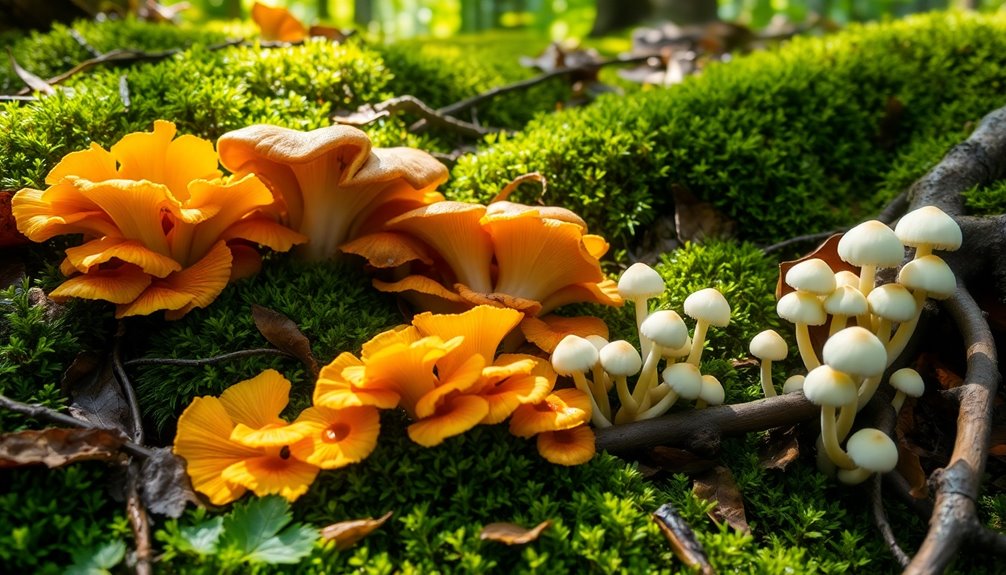
When you're out foraging for mushrooms, it's vital to spot the edible varieties among the many look-alikes. As a mushroom picker, you need to rely on your senses and a reliable Field Guide.
Start by learning to identify chanterelles, which boast a yellow-gold color and a fruity, apricot-like aroma. Their smooth to ridged underside sets them apart from toxic jack-o-lantern mushrooms that feature well-developed gills.
Next, keep an eye out for red pine mushrooms, or saffron milkcaps. Their dull orange/brown caps resemble small tree stumps, and their bright orange ribs underneath are a telltale sign.
Morels are another sought-after treat; their honeycomb appearance and hollow stem are distinctive. They thrive near ash, elm, poplar, and oak trees, especially from late March to late April.
Be cautious, though. The green-spored lepiota can be toxic and is often misidentified, so careful examination is important.
Finally, remember to cook your foraged mushrooms thoroughly. Even edible varieties like morels can cause stomach upset if consumed raw or improperly prepared.
Enjoy your foraging adventure!
Ethical Foraging Practices

When you forage for mushrooms, it's essential to practice sustainable harvesting techniques that respect natural habitats.
Take only what you need and leave immature mushrooms to grow, ensuring future foraging opportunities.
Sustainable Harvesting Techniques
Sustainable harvesting techniques are fundamental for preserving mushroom populations and guaranteeing that future foragers can enjoy nature's bounty. By practicing responsible foraging, you can contribute to the health of local ecosystems and guarantee that mushrooms continue to thrive.
Here are three key sustainable foraging practices to keep in mind:
- Take only what you need: Avoid overharvesting by collecting only the mushrooms you plan to use. This helps maintain healthy populations for future foragers.
- Use the right tools: Instead of uprooting mushrooms, use a knife to cut them at the base. This preserves the mycelium, which is essential for future growth and regeneration.
- Wrap your finds properly: Use wax paper to wrap collected mushrooms, preventing moisture loss and guaranteeing they stay fresh. Reducing waste is an important part of sustainable practices.
Engaging in community foraging groups can enhance your knowledge of sustainable techniques and foster a greater appreciation for biodiversity.
Respect for Natural Habitats
Respecting natural habitats is crucial for ethical foraging practices, as it guarantees that ecosystems remain intact and vibrant. In the wild mushroom industry, foragers must understand local regulations, especially in urban areas like Chicago, where legal restrictions on mushroom collection exist. This knowledge helps you avoid legal repercussions while ensuring sustainable practices.
When foraging, take only what you need. This approach prevents overharvesting and supports future mushroom populations. It's important to respect natural habitats by minimizing your impact; avoid damaging the ecosystem and leave no trace of your activities. Remember that many mushrooms form symbiotic relationships with trees, playing critical roles in nutrient exchange. Engaging with local foraging groups can deepen your understanding of sustainable practices and the importance of preserving natural habitats. Sharing knowledge with fellow foragers fosters a community committed to ethical foraging, ensuring that these ecosystems thrive for generations to come. Additionally, being aware of the impact of environmental factors can help you forage responsibly and sustainably.
Culinary Uses of Wild Mushrooms
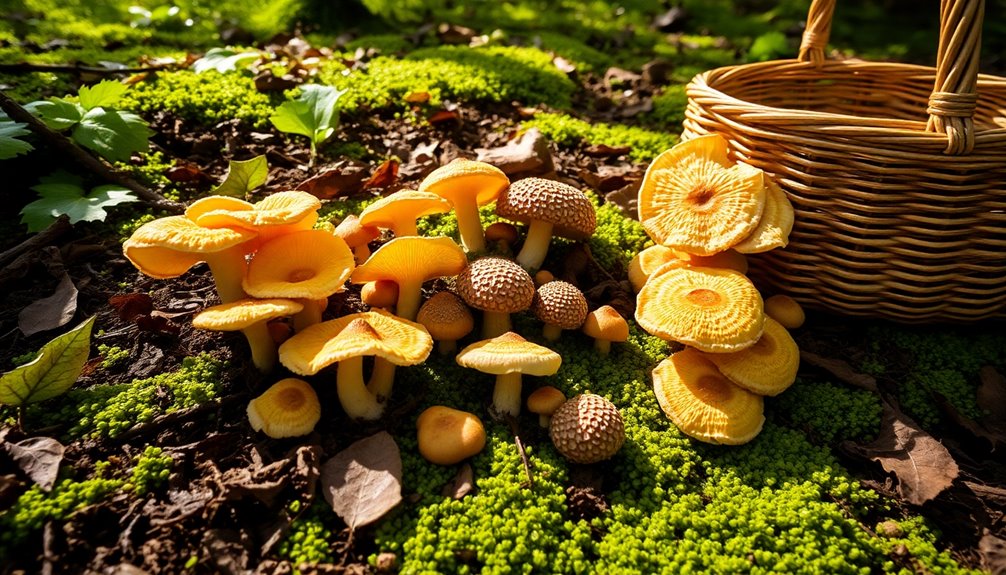
Wild mushrooms add depth and complexity to a variety of dishes, making them a favorite among culinary enthusiasts. Their unique flavors can elevate even the simplest meals. Here are three popular uses for wild mushrooms:
- Risottos: Incorporate morels for a rich, earthy flavor that complements the creamy texture.
- Pasta Dishes: Use chanterelles in your favorite pasta sauce, bringing an exciting twist to traditional recipes.
- Gourmet Sauces: Dried wild mushrooms can be rehydrated to enhance flavors in sauces, giving them an irresistible depth.
While morels need thorough cooking to avoid stomach upset, they're often sautéed in butter for a delightful side dish.
Chanterelles, on the other hand, shine in omelets or as a standalone side. The versatility of wild mushrooms is astonishing; they can even be used in dumpling fillings or as a key ingredient in savory pastries.
With the global trade of chanterelles reaching around $2 billion, it's clear that these mushrooms hold significant culinary and economic value.
Embrace their richness in your cooking, and you'll be rewarded with unforgettable meals.
Nutritional Benefits of Mushrooms
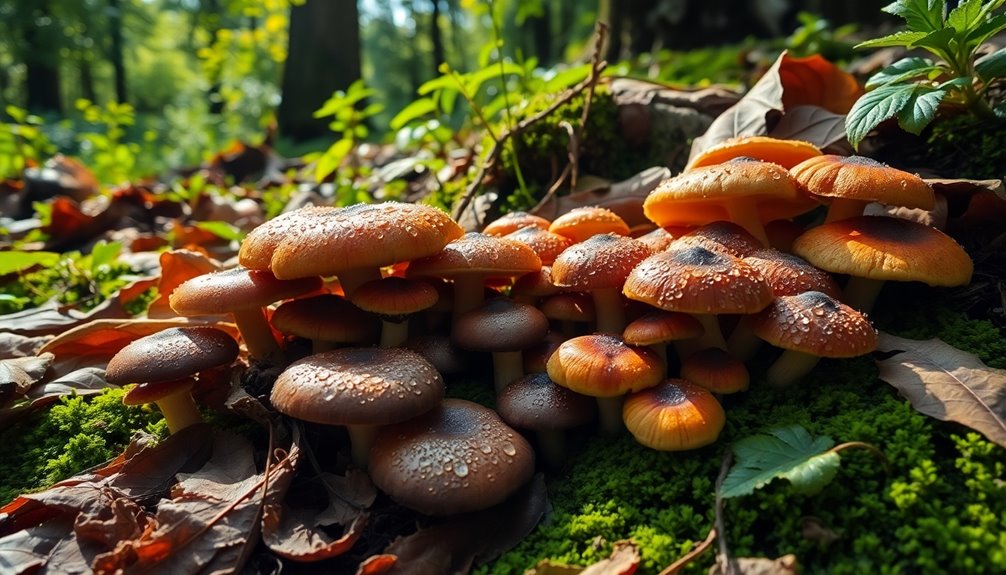
Mushrooms pack a powerful nutritional punch, making them an excellent addition to your diet. They're loaded with essential nutrients like iron, zinc, and potassium, which are crucial for your overall health and well-being.
When you compare wild mushrooms to common grains and plants, you'll find that they often exceed in nutritional value, providing you with exceptional health benefits.
Certain varieties, such as shiitake and maitake, are particularly significant for their potential immune-boosting properties and cancer-fighting capabilities. By including these mushrooms in your meals, you might be supporting your body's defenses against illness.
Additionally, mushrooms contain antioxidants that combat oxidative stress, a factor linked to various chronic diseases.
Don't overlook species like reishi and lion's mane, either. These mushrooms have been traditionally valued for their medicinal benefits, including promoting cognitive function and longevity.
Incorporating different types of mushrooms into your diet not only enhances your meals but also enriches your nutritional intake.
Safety Guidelines for Foragers
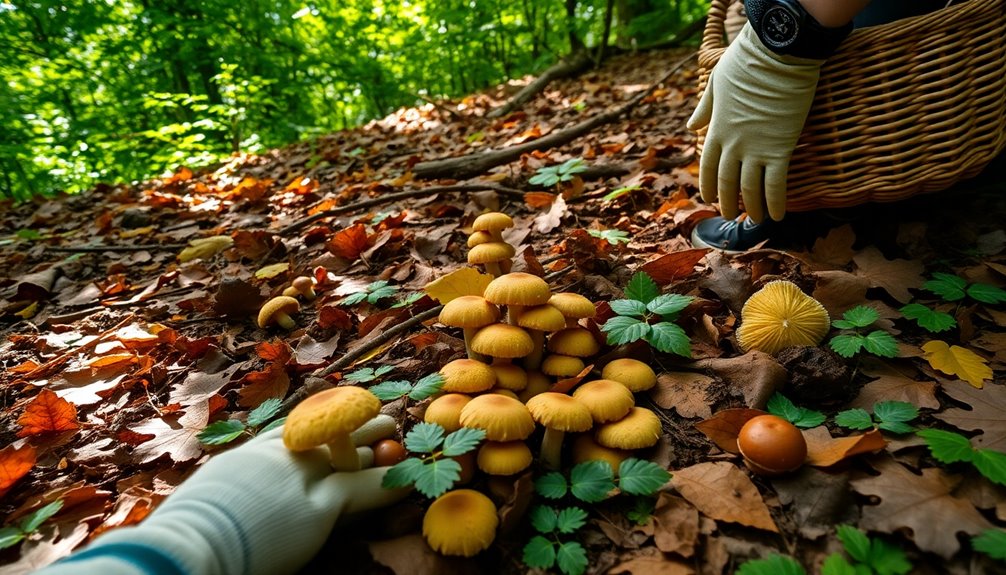
Foraging can be an exciting adventure, but it's vital to prioritize safety while you explore. Following these safety guidelines will help you enjoy your wild foods without worry:
- Learn from Experts: Always forage with a knowledgeable individual or guide. Misidentifying mushrooms can lead to severe health risks, so accurate identification is important.
- Equip Yourself Properly: Carry a hand lens, knife, and a flat-bottomed basket for harvesting. Avoid plastic bags, as they cause mushrooms to sweat and spoil.
- Dress for Protection: Wear long pants and long-sleeved shirts to shield yourself from poison ivy, insects, and thorny plants.
Additionally, make sure you're aware of local laws and regulations regarding mushroom foraging. Some areas, especially forest preserves, may have restrictions on collecting mushrooms.
Practice sustainable foraging by only taking what you need, leaving some mushrooms behind for future growth, and respecting the natural habitat.
The Joy of Mushroom Foraging

Imagine stepping into the forest, where every corner holds the promise of discovery and adventure. Mushroom foraging combines the thrill of a treasure hunt with the tranquility of nature walks. As you sift through the leaf litter, you'll uncover hidden gems like chanterelles in autumn or morels in spring, each bringing unique flavors to your kitchen.
Foraging isn't just about the mushrooms; it's a communal experience that fosters connections. You'll share tips, tales, and laughter with fellow foragers, creating a sense of family among those who appreciate the beauty of the forest.
As you walk, you'll deepen your connection to nature, gaining insight into the intricate relationships within ecosystems.
Sustainable foraging practices are essential. By respecting natural habitats and protecting mushroom populations, you promote environmental awareness while enjoying the bounties of the forest.
This mindful approach enhances your overall well-being, as each foraging trip becomes a lesson in biodiversity.
Frequently Asked Questions
Where Are the Best Mushroom Foraging Spots?
If you're looking for the best mushroom foraging spots, consider areas with mixed hardwood forests and rich, loamy soil.
Places like Lake James in North Carolina and South Mountains State Park are great choices.
If you're near Chicago, check forest preserves for chanterelles and black trumpets, but keep legal restrictions in mind.
In Northern California, the Redwood Highway is known for chanterelles and porcini during autumn.
Always research local regulations before foraging!
What Time of Year Would You Be Most Likely to Find a Golden Chanterelle?
If you're looking for golden chanterelles, think of them like summer vacation—best from late spring through early autumn, peaking around June to September.
They pop up after good rain in warm, moist conditions, especially beneath oak, beech, or fir trees.
Keep an eye on the weather; temperatures between 60°F and 75°F are ideal.
Just remember, your local climate can influence their availability, so stay sharp while foraging!
Where Is the Best Place to Go Mushroom Hunting?
The best places for mushroom hunting often involve rich, moist environments.
Look for locations like forest preserves, state parks, or areas with a mix of hardwood trees. These habitats typically support a diverse fungal population.
In particular, spots near water sources with ample shade can yield great results.
Pay attention to the seasonal changes, as they greatly influence mushroom availability.
Research local hotspots to maximize your foraging adventures and enhance your culinary finds.
Where Is the Mushroom Hunter Located?
You'll find mushroom hunters scattered across various terrains, from lush forests to urban areas.
They often venture into specific locations like North Carolina for morels or the Redwood Highway in California for chanterelles and porcini.
In the Chicago area, they're foraging in diverse habitats, searching for chanterelles near oak trees.
These passionate foragers traverse challenging landscapes, averaging about 15 kilometers daily, as they seek out those culinary treasures hidden beneath the forest floor.
Conclusion
Mushroom foraging is like a treasure hunt in nature's pantry, where each find is a golden nugget waiting to be discovered. As you step into the woods, remember the thrill of the chase and the joy of connecting with the earth. By following ethical practices and honing your identification skills, you'll not only enhance your culinary repertoire but also deepen your appreciation for the wild. So grab your basket and embrace the adventure—nature's bounty awaits!

